JMS Pearce
East Yorks, England
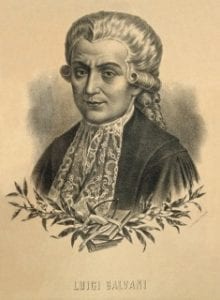
From Wellcome Collection. Attribution 4.0
International (CC BY 4.0)
Physicist or physician? Scientist or healer? Artificially, these are divisions that have classified doctors through the ages. Luigi Galvani (1737-1798) (Fig 1.) showed that it was possible to be an amalgam of both. The word “galvanize” derives not from physics but from Galvani, a medical doctor who studied electricity in animal tissues. The term galvanize that perpetuates his name now has several meanings: to stimulate by means of a galvanic current; (metaphorically) to shock or excite someone into taking action; or as a coat of iron or steel with a protective layer of zinc.
Luigi Galvani was born in Bologna on September 9, 1737. Following his father, he studied medicine at the University of Bologna, graduating in 1759 and acquiring a doctorate in 1762 with a thesis on bones: De ossibus. He was appointed lecturer in anatomy at Bologna and professor of obstetrics. Though in Galvani’s case unnecessary, to wed your boss’s daughter was ever a prudent ploy: he married Lucia in 1762, daughter of his anatomy professor, Domenico Galeazzi, a pupil of Malpighi.
The nature of electricity
Electricity was an important discovery of the sixteenth and seventeenth centuries. Only the “static” form was known until the late eighteenth century. In the 1770s Galvani applied the principles of electricity to an animal form when he began to experiment on the physiology of the frog.1 He obtained an electrostatic machine that created sparks, and a Leyden jar that stored static electricity.
The background of electric forces was a saga of fascinating and often accidental discoveries, important to Galvani’s experiments. The physician William Gilbert a.k.a Gilberd (1544 – 1603) practiced in London and in 1600 became president of the Royal College of Physicians and physician to Queen Elizabeth I. Gilbert studied the magnetic properties of lodestone, magnetic iron ore, published in his De Magnete, Magneticisque Corporibus, et de Magno Magnete, Tellure, Physiologia nova. Fol., Lond. 1600.i It was praised by Galileo. He realized the earth was a huge magnet with iron at its core. He demonstrated static electricity by rubbing amber — ἤλεκτρον, electron in Greek — and called its effect the electric force. Many investigators began to study electricity.2
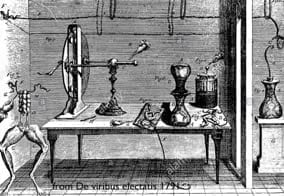
Fig 2. An illustration of Galvani’s frog leg
experiment that appeared in his treatise De viribus
electricitatis in motu musculari. Wikimedia Commons
In 1752 Benjamin Franklin (1706-1790), by flying a silk kite during a thunderstorm, proved that lightning was an example of electric conduction. He collected electric charge from a cloud with a wet twine attached to a key placed in a Leyden jar. When scientists first studied electric currents they believed that the flow was produced by motion of tiny particles with a positive charge.3 Subsequently it was shown to be a flow of negatively charged particles: electrons. Joseph Priestley (1733-1804) explained the terms “positive” and “negative,” “charging” and “discharging,” and “battery.” Encouraged by Franklin, Priestley designed an electric machine for generation and storage, illustrated in his A Familiar Introduction to Electricity (1768). Charles-Augustin de Coulomb, (1736-1806), Georg Simon Ohm (1789–1854), and André-Marie Ampère (1775 – 1836) performed famous experiments on electrical effluvia. After Galvani, Volta’s first electric pile of zinc and silver (or copper and pewter) was described in 1800. Both Michael Faraday (1791-1867) and James Clerk Maxwell (1831–1879) were later to report their revolutionary experiments of electrical induction and electro-magnetism.
Electric Powers in nerves
Decades earlier, the idea that nerve conduction might be electrical was suggested by Stephen Hales (1677-1761), curate of Teddington.4
The nervous system as the regulator of physiological functions had been suspected since the time of Descartes. As a result, the postulated spiritus vitalis was located in the nerves. In the third edition of Haemastaticks, 1740, (p.55.) Hales made the startling suggestion that perhaps nerves functioned by conducting “electrical powers.” This was based on experiments in which he decapitated a frog and thirty hours later observed it move its body when stimulated, and convulse when he thrust a needle down the spinal marrow. This was the first observation of spinal reflexes and their abolition by destruction of the cord. It was quoted in Robert Whytt’s (1714-66) Physiological Essays 1755, two years before Whytt’s own description of reflex action. Hales deduced:
Muscular contraction must therefore be owing to some more vigorous and active Energy whose Force is regulated by the Nerves; But whether it be confined to the Canals within the Nerves, or acts along their Surfaces like electrical Powers, is not easy to demonstrate.5
Almost a century later Du Bois-Reymond (1818-1896) proved that the passage of a nerve impulse was accompanied by an electrical discharge6 named the action potential.7 He invented a refined nerve galvanometer and a stimulus-producing induction coil.
The Galvani Volta debate
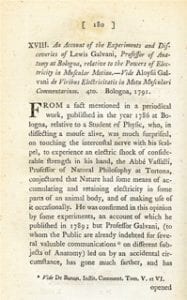
motu musculari commentarium, 1791.
A much-repeated story tells how in 1871 Galvani’s wife was preparing a frog for soup; when she accidentally touched it with a knife a muscle contraction occurred, despite the frog not being connected to his electrical machine. He repeated the experiments and deduced that twitching was caused by electrical action (Fig 2.). During an electrical storm he elicited muscular contraction in a frog by touching its nerves with a pair of scissors. Galvani later reported a similar, accidental observation:
When one of the assistants by chance lightly applied the point of a scalpel to the femoral nerves of a dissected frog, suddenly all the muscles of the limbs were seen to contract, they appeared to have fallen into violent tonic convulsion. … Another assistant had observed a spark was discharged from the conductor of a nearby electrical machine (Galvani. De viribus,1791)9
He also elicited twitching without the electrostatic machine by pressing a bronze hook onto a frog’s spinal cord and hanging the hook on an iron rail. Galvani concluded that animal tissue contained an innate, vital “animal electricity” that activated nerve and muscle when spanned by metal probes. He believed that this form of electricity was additional to the “natural” form produced by lightning or by the electric eel and torpedo ray, and distinct from the shock produced by friction (i.e. static electricity). In 1791, after years of delay, he published his famous essay De Viribus Electricitatis in Motu Musculari Commentarius (Commentary on the Strength of Electricity on Muscular Motion)(Fig 3.).8
However, the highly respected Alessandro Volta (1745–1827) asserted Galvani was wrong. (The volt, a unit of the electromotive force that drives current, was named in his honor in 1881.) Volta believed that electricity detected by Galvani was not innate in the animal but simply due to electric currents produced by a completed circuit that connected dissimilar metals. Using two metals (silver and zinc) he invented the Voltaic pile, or battery. A spirited debate lasted many years.9,10At first Volta’s doctrine prevailed over Galvani’s. But Galvani later proved his concept of intrinsic electrical activity when without an electrical source he elicited muscular contraction by placing the spinal stump and sciatic nerve in contact with the frog’s leg of the opposite side.
His ideas were reiterated by Leopoldo Nobili (1784-1835), who in 1828 measured the corrente di rana (frog current) with his galvanometer, and in 1838 by Carlo Matteucci (1811-68).11 Although Volta’s suggestion that two metals connected with a frog could generate electricity was correct, Galvani’s suggestion that the nerves and muscle generated their own internal electricity was also later confirmed when electrical impulses in nerves were observed.12 He also caused a muscle to contract by touching the exposed muscle of one frog with the nerve of another and thus crucially concluded that bioelectric forces exist within living tissue.
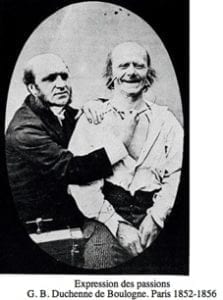
of muscles of facial expression.
But Volta, a man of piety, and the deeply religious Galvani bore no personal animosity, and indeed Volta praised Galvani and used the term galvanism. Volta eventually wrote to the Royal Society in 1793 that there was proof of a genuine animal electricity in all or nearly all animals.2
The singular importance of Galvani’s physiological work was that by applying electrical stimuli to animals he had shown that neuromuscular activity depended on electrical forces.13 He continued to work as teacher, obstetrician, and surgeon, treating both the rich and the needy without regard to fees. He defended his ideas in an anonymous book, Dell’uso e dell’attività dell’arco conduttore nella contrazione dei muscoli (On the Use and Activity of the Conductive Arch in the Contraction of Muscles) published in 1794. This recorded experiments in which muscular contraction occurred without the need of any metal.
Towards the end of his life, Galvani refused to swear allegiance to the new undemocratic Cis-Alpine republic in Italy.14 He was therefore removed from the faculty and his salary was stopped. After two years of financial hardship his Chair was restored without the requirement of an oath. He died in the house of his birth, aged 61.
His work was continued by his nephew Giovanni Aldini (1762-1834) and by the English physician Richard Fowler, MD, FRS (1765–1863), whose numerous experiments were published in 1793 as Experiments and observations on the influence lately discovered by M. Galvani, and commonly called animal electricity.ii His observations on muscular irritability caused by electricity were influential. His work also included notes on the action of opium on nerves and muscles.
Galvani had provided the major stimulus for the Voltaic pile, and the battery that led to the age of electric power.15 His work eradicated primitive notions of demonic or divine forces, miasma, and the elusive spiritus animalis; it founded a new science, electrophysiology. André-Marie Ampère named the galvanometer after him, and galvanization became the technique of covering iron or steel with a layer of zinc to prevent rusting.
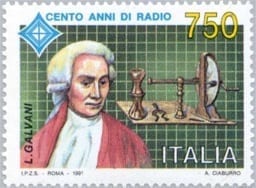
Fig 5. Galvani commemorative stamp.
Galvanism was often used both to treat mental illness and to revive people after drowning or lightning strikes. After the 1820s galvanic stimuli were used indiscriminately for many conditions, including gout, fever, hydrocephalus, blindness, deafness, and genitourinary infections.16 Both Faradic and Galvanic stimulation were employed by Duchenne de Boulogne (1806-1875),17 who correlated clinic-pathological findings with electrical tests he used in diagnosis and prognosis.18 (Fig 4.) Charles Darwin corresponded with Duchenne and used his findings and photographs of the facial musculature in his The Expression of the Emotions in Man and Animals, 1872.
Galvani was both modest and assertive, but at times was reluctant to publish and thus of his many discourses and lectures during the twenty-five years before the appearance of his famous “De viribus electricitatis,” only three, making a total of thirty printed pages, appear to have been published.19 Giovanni Aldini (1762-1834), professor of physics in Bologna, stoutly defended his uncle’s thesis in lectures at Guy’s and St. Thomas’s Hospitals.20 In a spectacular public demonstration at the Royal College of Surgeons in 1803, on a hanged man named George Forster, Aldini applied conducting rods charged from a battery with resulting grotesque muscular contractions.
An Italian stamp commemorated Galvani on the occasion of the First International Congress of Electro-Radio-Biology (Fig 5.). Every two years the Bioelectrochemical Society gives the Luigi Galvani Prize.
End Notes:
- English translation by Silvanus Phillips Thompson, 1900
- Galvanism is electricity produced by contact, as opposed to Faradism, electricity caused by induction.
References:
- Bresadola M. Medicine and science in the life of Luigi Galvani (1737-1798). Brain Res Bull. 1998 Jul 15;46(5):367-80.
- Spillane JD. Doctrine of the Nerves. Oxford. Oxford University Press 1981; pp.145-158.
- Sharon Bertsch McGrayne, Edwin Kashy et al. Electromagnetism. Encyclopædia Britannica, July 26, 2018. https://www.britannica.com/science/electromagnetism/Historical-survey Access Date: April 12, 2019.
- Pearce JMS. Stephen Hales: the priest who pioneered clinical physiology. Hektoen Intl. Winter 2017.
- Hales Stephen. Statistical essays containing haemostaticks (3rdedn.). W. Innys and R. Manby (1769; vol 2. p. 57. Cited by Spillane,2p.150.
- Du Bois Reymond E. Untersuchungen über thierische Elektikstät. Vol. 2, pp. 425-30. Berlin. G Reimer 1849. cited in Clarke E, and O’Malley CD. The Human Brain and Spinal Cord: A Historical Study. 2nd edn San Francisco, Norman. 1996, pp. 192-203.
- Pearce J.M.S., Historical note. Emil Heinrich Du Bois-Reymond (1818–96) J. Neurol Neurosurg Psychiatry , 2001 ;71 : 620.
- Galvani L. De Viribus Electricitatis in Motu Musculari Commentarius(Commentary on the Effect of Electricity on Muscular Motion,)1791. Licht, Cambridge Massachusetts 1953, transl by RM Green.
- Kipnis N. Luigi Galvani and the debate on animal electricity, 1791-1800. Annals of Science 1987;44: 107-142.
- Piccolino M, Bresadola M.Shocking Frogs: Galvani, Volta, and the Electric Origins of Neuroscience. Oxford, New York. Oxford University Press2013.Isler H. Romantic origins of electrophysiology. Schweiz Rundsch Med Prax. 1992;81(49):1485-8.
- McComas AJ. Galvani’s Spark. Oxford University Press, 2011
- DeLOne N. Luigi Galvani: a short portrait. Hektoen Int, January 28, 2017
- Piccolino M. Luigi Galvani’s path to animal electricity. C R Biol. 2006;329(5-6):303-18. Epub 2006 Mar 30.
- Piccolino M. Animal electricity and the birth of electrophysiology: the legacy of Luigi Galvani. Brain Res Bull. 1998; 15: 46(5):381-407.
- Price James. An Essay on the Medical Application of Electricity and Galvanism; with a Concise Descriptive Account of Disease, London, Underwood. 1821
- Pearce JMS. Some contributions of Duchenne de Boulogne (1806-1875). J Neurol Neurosurg Psychiatry 1999;67:322
- Duchenne GBA. De L’électrisation Localisée et de son application à la Pathologie et à la Thérapeutique.’. 1855,
- Editorial. The Writings of Galvani. Nature 1937;140:840–841.
- Fulton JF, Cushing H. A bibliographical study of the Galvani and the Aldini writings on animal electricity. Annals of Science 1936; 1:239-268.
JMS PEARCE, MD, FRCP, is a retired neurologist and author with a particular interest in the history of science and medicine.

Leave a Reply